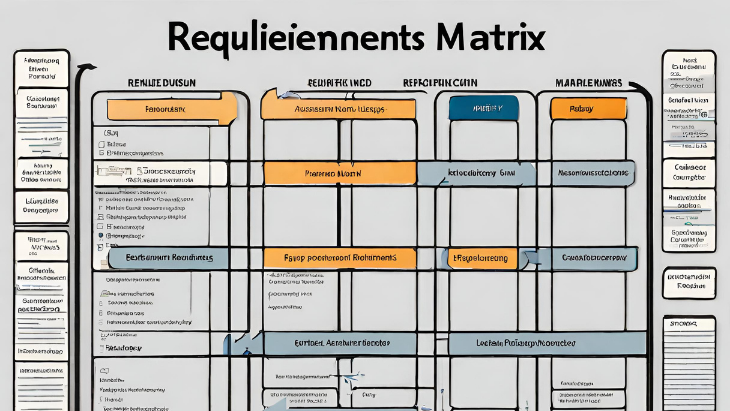A requirements matrix is a document that helps teams track and manage the requirements for a project. It is a valuable tool for ensuring that all requirements are met and that the project meets the needs of its stakeholders.
Requirements matrix definition
A requirements matrix is a document that helps teams track and manage the requirements for a project. It is a valuable tool for ensuring that all requirements are met and that the project meets the needs of its stakeholders.
A requirements matrix typically includes the following columns:
- Requirement: The specific requirement that needs to be met
- Description: A brief description of the requirement
- Priority: The importance of the requirement
- Status: The current status of the requirement
- Owner: The person or team responsible for the requirement
- Acceptance criteria: The criteria that must be met for the requirement to be considered complete
Requirements matrices can be used to track requirements throughout the entire project lifecycle, from the initial requirements gathering phase to the final testing phase. They are an essential tool for ensuring that projects are completed on time and within budget, and that they meet the needs of all stakeholders.
Here are some of the benefits of using a requirements matrix:
- Improved communication and collaboration: A requirements matrix can help to ensure that all stakeholders are on the same page about the requirements for a project.
- Increased efficiency: A requirements matrix can help teams to track progress and identify potential risks or issues early on.
- Reduced risk: A requirements matrix can help to ensure that all requirements are met, which can reduce the risk of project failure.
How to create a requirements matrix
To create a requirements matrix, you will need to gather all of the requirements for your project. This can be done by interviewing stakeholders, reviewing existing documentation, and conducting surveys. Once you have gathered all of the requirements, you can create a matrix by entering them into a spreadsheet or other document.
When creating your requirements matrix, be sure to include all of the relevant information, such as the requirement, description, priority, status, owner, and acceptance criteria. You may also want to include additional columns, such as the date the requirement was created, the date it was last updated, and the date it is expected to be completed.
Requirements matrix example
Here is an example of a requirements matrix for a software development project:
| Requirement | Description | Priority | Status | Owner | Acceptance criteria |
|---|---|---|---|---|---|
| The system must allow users to create an account using an email address and password. | Users will be able to create an account by providing their email address and password. | High | In progress | Developer | The system will accept valid email addresses and passwords. |
| The system must allow users to log in using their email address and password. | Users will be able to log in to the system by providing their email address and password. | Medium | In progress | Developer | The system will accept valid email addresses and passwords. |
| The system must allow users to view their account information. | Users will be able to view their account information, such as their name, email address, and password. | Low | In progress | Developer | The system will display the user’s account information correctly. |
This is just a simple example, and the specific requirements for your project will vary depending on the type of project you are working on. However, this example should give you a good idea of how a requirements matrix is structured.
Here are some additional tips for creating a requirements matrix:
- Use clear and concise language. The requirements matrix should be easy to understand by everyone involved in the project.
- Be as specific as possible. The requirements should be specific enough to be measurable.
- Prioritize the requirements. Not all requirements are created equal. Prioritize the requirements so that the most important ones are completed first.
- Get input from stakeholders. The requirements matrix should be a collaborative effort between the project team and the stakeholders.
How to create a requirements matrix
A requirements matrix is a document that helps teams track and manage the requirements for a project. It is a valuable tool for ensuring that all requirements are met and that the project meets the needs of its stakeholders.
To create a requirements matrix, you will need to follow these steps:
- Gather the requirements. The first step is to gather all of the requirements for your project. This can be done by interviewing stakeholders, reviewing existing documentation, and conducting surveys.
- Create the matrix. Once you have gathered all of the requirements, you can create the matrix by entering them into a spreadsheet or other document.
- Fill in the information. For each requirement, you will need to include the following information:
- Requirement: The specific requirement that needs to be met
- Description: A brief description of the requirement
- Priority: The importance of the requirement
- Status: The current status of the requirement
- Owner: The person or team responsible for the requirement
- Acceptance criteria: The criteria that must be met for the requirement to be considered complete
- Review and approve the matrix. Once you have created the matrix, it is important to review it with stakeholders to ensure that it is accurate and complete.
Here are some additional tips for creating a requirements matrix:
- Use clear and concise language. The requirements matrix should be easy to understand by everyone involved in the project.
- Be as specific as possible. The requirements should be specific enough to be measurable.
- Prioritize the requirements. Not all requirements are created equal. Prioritize the requirements so that the most important ones are completed first.
- Get input from stakeholders. The requirements matrix should be a collaborative effort between the project team and the stakeholders.
A requirements matrix is a valuable tool that can help you to track and manage the requirements for your project. By following these tips, you can create a requirements matrix that is clear, concise, and effective.
Requirements matrix template
A requirements matrix is a document that helps teams track and manage the requirements for a project. It is a valuable tool for ensuring that all requirements are met and that the project meets the needs of its stakeholders.
A requirements matrix template is a pre-formatted document that can be used to create a requirements matrix. Templates can be a helpful starting point, as they provide a structure and a list of the information that should be included.
There are many different requirements matrix templates available online and in project management software. When choosing a template, it is important to consider the specific needs of your project.
Here are some of the things to consider when choosing a requirements matrix template:
- The type of project: Some templates are designed for specific types of projects, such as software development or product development.
- The complexity of the project: More complex projects may require a more detailed template.
- The needs of the stakeholders: The template should be able to meet the needs of all stakeholders, including the project team, the customers, and the management.
Here is an example of a requirements matrix template:
| Requirement | Description | Priority | Status | Owner | Acceptance criteria |
|---|
This template is simple and straightforward, and it can be customized to meet the specific needs of your project.
Here are some additional tips for using a requirements matrix template:
- Use the template as a starting point, and then customize it to meet the specific needs of your project.
- Make sure that all stakeholders are involved in the creation of the requirements matrix.
- Review the requirements matrix regularly to ensure that it is accurate and up-to-date.
By using a requirements matrix template, you can save time and effort when creating a requirements matrix.
Requirements matrix tool
A requirements matrix tool is a software application that can be used to create and manage requirements matrices. These tools can be a valuable asset for project teams, as they can help to streamline the requirements gathering and management process.
There are many different requirements matrix tools available on the market. Some of the most popular tools include:
- Microsoft Excel: Excel is a spreadsheet application that can be used to create a simple requirements matrix.
- Project management software: Project management software often includes a requirements matrix feature.
- Requirements management software: Requirements management software is specifically designed for managing requirements.
When choosing a requirements matrix tool, it is important to consider the following factors:
- The type of project: Some tools are designed for specific types of projects, such as software development or product development.
- The complexity of the project: More complex projects may require a more powerful tool.
- The needs of the stakeholders: The tool should be able to meet the needs of all stakeholders, including the project team, the customers, and the management.
Here are some of the benefits of using a requirements matrix tool:
- Increased efficiency: Requirements matrix tools can help teams to automate the requirements gathering and management process.
- Improved accuracy: Requirements matrix tools can help teams to ensure that requirements are accurately documented and tracked.
- Enhanced collaboration: Requirements matrix tools can help teams to collaborate more effectively on requirements.
By using a requirements matrix tool, project teams can improve the efficiency, accuracy, and collaboration of their requirements management process.
Here are some additional tips for using a requirements matrix tool:
- Use the tool to its full potential: Many requirements matrix tools offer a variety of features that can be used to improve the requirements management process.
- Get input from stakeholders: Ensure that all stakeholders are involved in the use of the requirements matrix tool.
- Review the requirements matrix regularly: Regularly review the requirements matrix to ensure that it is accurate and up-to-date.











